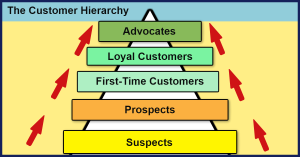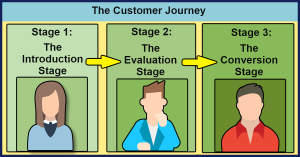Today, content is how companies build an audience, build trust, and convert prospects into paying customers.
Creating content requires time, resources, and money. Each piece of content needs to have a purpose and a specific objective.
Businesses and copywriters need to understand the purpose of each piece of content, and the objective it is trying to achieve.
A few goals can be to generate traffic, to engage an audience, to build trust, to demonstrate knowledge of a topic, to introduce a new problem to an audience, to overcome an objective, or to ascend a customer to the next level of the customer hierarchy.
Before copywriters can create content to move customers throughout the customer journey, it is vital to understand the customer journey.
Businesses need to know and justify why they are creating each piece of content.
How does content move suspects, prospects, and customers throughout the stages of the customer journey?
Before I reveal how to relate different types of content to the customer journey, let’s define the different types of customers within a customer journey.
The 5 levels in a Customer Hierarchy in a Typical Customer Journey
Suspects — targeted individuals who the business thinks are interested in their products and services.
Prospects — suspects who raise their hand and say they are interested.
First-Time Customers — people who purchase a product or service from a business for the first time.
Loyal Customers — customers who purchase often and who are less sensitive to price.
Advocates — the most valuable customers to a business. These are the most loyal customers, who purchase the most frequently and at the highest price points. Also, advocates tell the most people about a business and generate the most referrals.
Creating Different Types of Content for Different Stages of the Customer Journey
Now let’s examine how the customer hierarchy relates to the customer journey.
First, let’s establish the definition of a customer journey.
SurveyMonkey defines the customer journey as “the complete sum of experiences that customers go through when interacting with your company and brand. Instead of looking at just a part of a transaction or experience, the customer journey documents the full experience of being a customer.”
Here is how businesses can create different types of content to move customers through the customer journey.
The 3 Stages of a Typical Customer Journey
Stage 1: The Introduction Stage — Suspects are introduced and then learn more about the company
First, content attracts new suspects during the Introduction Stage. This is when suspects are first introduced to the business and are learning about the company.
During the Introduction Stage, a targeted suspect may notice a piece of content, such as a social media post. The social media post may promote a blog post or podcast episode. The suspect clicks on the social media post and then visits the business’s website to consume the content. At this stage, the person may notice other pieces of content that interest them. Next, the suspect may learn more about the company and its products and services.
Types of content that companies need for this stage of the customer journey are:
| • Blog posts
• Social media posts • Infographics • Photographs |
· Listicles
· Podcasts · Print magazines · Snail-mail newsletters
|
A skilled writer can assist a business in creating engaging content for the Introduction Stage.
According to the Content Marketing Institute’s B2B Content Marketing 2020 Benchmarks, Budgets, and Trends — North America, “50% of B2B marketers outsource content creation.”
So many businesses outsourcing content development creates a massive opportunity for beginning writers, content creators, and direct-response copywriters to produce content for the Introduction Stage.
There is a high demand for writers who create content for the Introduction Stage.
An example is the ongoing demand and need for blog posts.
According to HubSpot, “Companies that publish 16+ blog posts per month get 3.5X more traffic than those that post four or fewer posts per month.”
Stage 2: The Evaluation Stage — The Suspect Becomes a Prospect
The second stage, or the middle of the customer journey, is known as the Evaluation Stage. During this stage, suspects become prospects, who raise their hand and say they are interested. At this point, the customer opts-in for a lead magnet. To opt-in, the suspect provides their name and email address in exchange for something of value, called a lead magnet. Now, through email marketing, the business can start building a relationship with the prospect.
Types of content businesses need for this stage are:
| · Lead magnets
· White papers · Case studies · Free guides · Free e-books |
· Reports
· Landing pages · E-newsletters · Promotional emails · Autoresponders.
|
The way a business deepens a relationship with an audience and builds trust is through email marketing.
Email marketing is one of the most profitable marketing channels today.
According to the Direct Marketing Association, “email marketing yields a 4,300% Return on Investment for small businesses in the United States.”
VentureBeat indicates that “email is the channel getting the highest ROI for marketers.”
iContact reports that “59% of marketers cite email as their biggest source of ROI.”
In an article by LiveWire.com called 19 Fascinating Email Facts published on March 15, 2020:
- “The number of worldwide email users is expected to grow to more than 4.3 billion by the end of 2023.”
- “The total number of business and consumer emails sent and received per day exceeded 293 billion in 2019 and is forecast to grow to more than 347 billion by the end of 2023.”
For the foreseeable future, there is an incredible opportunity for writers to focus on creating content for the Evaluation Stage. For writers concentrating on email, it leads to long-term retainer agreements because businesses need to send emails at least once per week.
The B2B writers who focus on writing content for the Evaluation Stage can develop an in-demand, high level, high paying skill.
Stage 3: The Conversion Stage — Customers, Customers, Customers
The final stage of a customer journey is the Conversion Stage. During this stage, prospects become customers, first-time customers become loyal customers, and loyal customers become advocates.
Types of content needed for this stage are:
- Short-form sales letters
- Long-form sales letters
- Video Sales Letters
- Webinars
- Check-out pages
- Order forms
This stage is for skilled direct-response writers. Long-form sales letters are the crème de la crème of direct marketing.
Acquiring a Customer Can Be Challenging
According to HubSpot’s The Ultimate List of Marketing Statistics, “Only 22% of businesses are satisfied with their conversion rates online.”
These low conversion rates prove that there is an enormous opportunity for writers who want to learn how to write long-form sales letters for front and back-end promotions.
A front-end promotion usually targets a lower-priced product whose purpose is to convert a prospect to a first-time customer.
Back-end promotions sell higher-priced products intended for people who are already customers. These higher-priced products can be easier to sell because the person is already a customer, had a positive experience, and is familiar with the organization.
To sell back-end products, businesses need long-form sales letters, Video Sales Letters, and webinars. These products are promoted through one-click upsells, autoresponders, newsletters, and promotional emails.
But even highly paid writers who write content for the Conversion Stage can develop a new high-paying skill.
For businesses to have a pipeline of customers, the key is creating content for the different stages of the customer journey.
Businesses need different types of content that engage an audience, build trust, and convert prospects into paying customers.
By understanding the various stages of the customer hierarchy and how it relates to the customer journey, copywriters can create a wide variety of content to benefit businesses.

